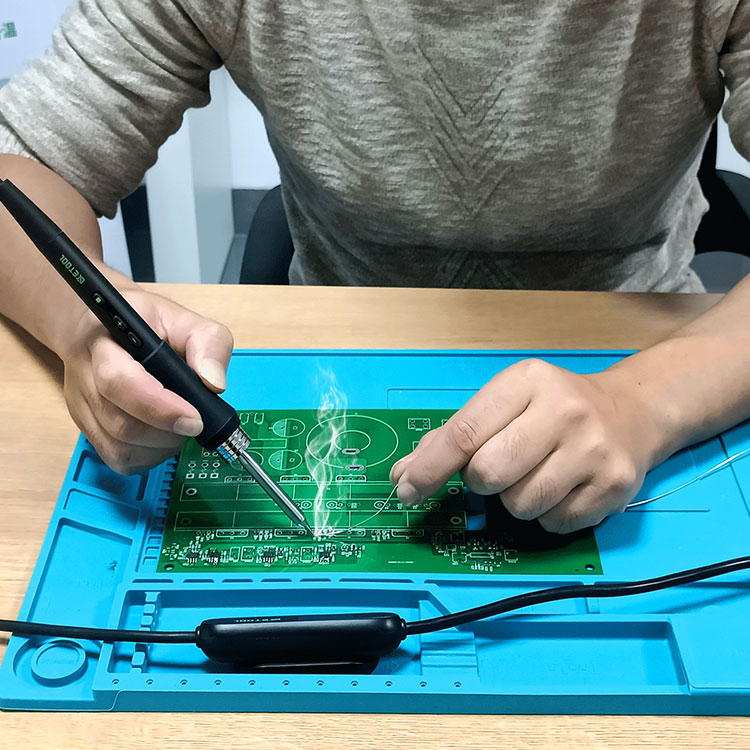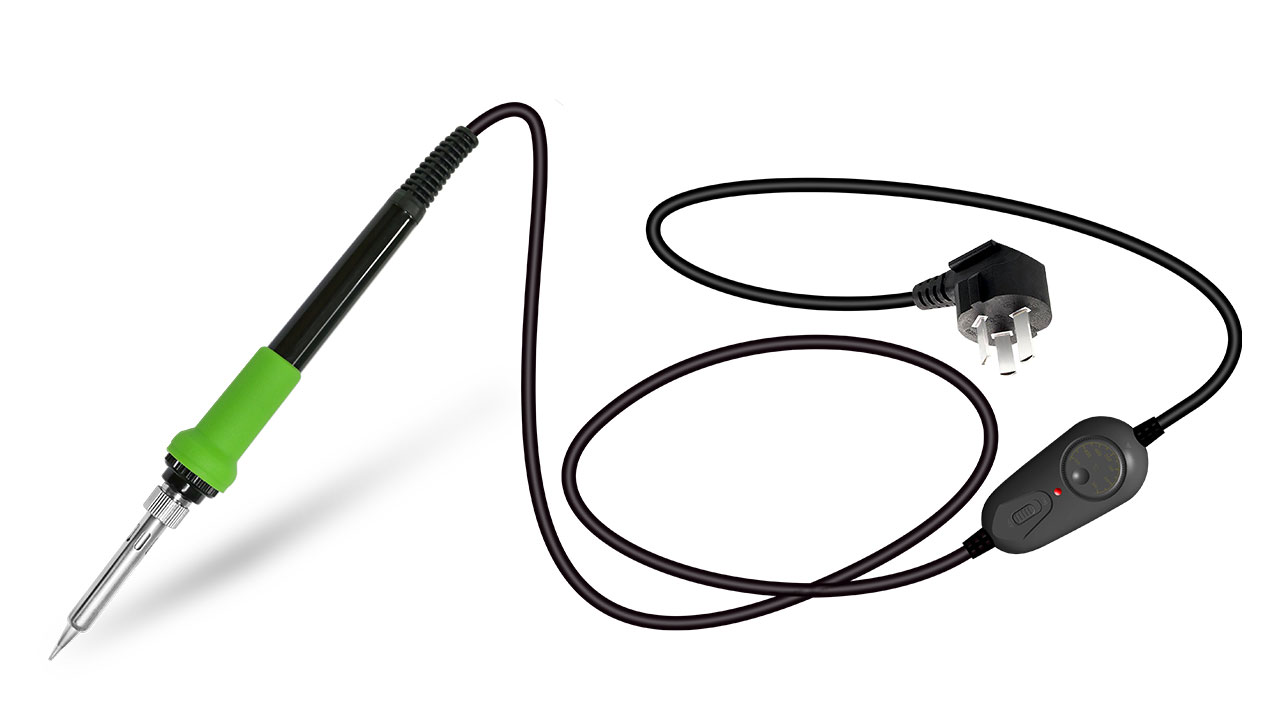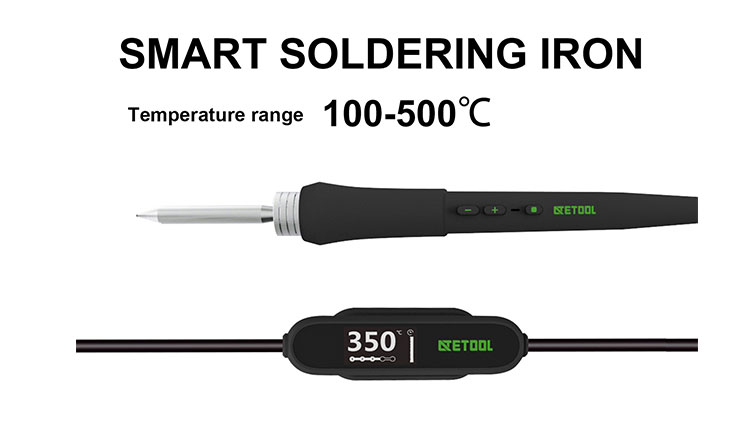A soldering iron's temperature ensures strong, reliable connections when soldering electronic components. If the temperature is too low, the solder may not flow properly and the connection may be weak or unreliable. On the other hand, if the temperature is too high, the components may be damaged or even melted. This is why a soldering iron needs to come with temperature control.
One of the key benefits of a soldering iron with temperature control is adjusting the heat as needed for different soldering tasks. Different components and materials require different temperatures for optimal soldering, and a soldering iron with temperature control allows you to adjust the heat as needed easily.
For example, when soldering SMDs, a lower temperature is typically required to avoid damaging the delicate components. On the other hand, when soldering through-hole components, a higher temperature may be needed to ensure that the solder flows properly and creates a strong connection. With a soldering iron with temperature control, you can easily adjust the heat to suit the specific soldering task.
Another benefit of a soldering iron with temperature control is maintaining a consistent temperature. When soldering, it's important to maintain a consistent temperature to ensure that the solder flows properly and creates a strong connection. If the temperature fluctuates, the quality of the connection may be compromised.
A soldering iron with temperature control allows you to set the desired temperature and maintain it throughout the soldering process. This helps to ensure that the temperature remains consistent, resulting in stronger, more reliable connections.
In addition to the benefits of temperature control for the soldering process, a soldering iron with temperature control is also safer. High temperatures can be dangerous, especially if the soldering iron is left unattended or used by someone not experienced in soldering. Soldering iron with temperature control allows you to set a maximum temperature, preventing the iron from overheating and reducing the risk of accidents or injuries.
Another benefit of a soldering iron with temperature control is the ability to extend the life of the iron and its tip. Overheating a soldering iron can cause the tip to deteriorate faster, leading to reduced performance and a shorter lifespan. With temperature control, you can avoid overheating the iron and its tip, helping to extend its lifespan and save money in the long run.
Additionally, a soldering iron with temperature control can also be more energy-efficient. By accurately controlling the temperature, you can avoid using more heat than necessary, reducing energy consumption and potentially saving on electricity costs.
In addition to the benefits of temperature control for the soldering process, safety, and the lifespan of the soldering iron and its tip, a soldering iron with temperature control is also often more versatile. With the ability to easily adjust the temperature, a soldering iron with temperature control can be used for a wider range of soldering tasks, from delicate SMD soldering to soldering larger components and PCBs. This makes a soldering iron with temperature control a more versatile and useful tool in your electronics toolkit.
In conclusion, a soldering iron with temperature control offers many benefits, including the ability to adjust the heat as needed, maintain a consistent temperature, extend the iron's lifespan and tip, be more energy-efficient, and be more versatile. For these reasons, choosing a soldering iron with temperature control is important to ensure that you have the best tool for your soldering needs.
There are a few different options when looking for a soldering iron with temperature control. One option is a soldering iron with a built-in temperature control feature, which allows you to easily adjust the temperature using a dial or button on the iron itself.

Another option is a soldering station consisting of a soldering iron and a separate temperature control unit. The temperature control unit allows you to set the desired temperature, and the soldering iron automatically adjusts its heat to maintain the temperature. This can provide more precise temperature control and be useful for more advanced soldering tasks.

Also, soldering irons can be paired with a separate temperature control unit using a connection such as a USB or Bluetooth. This allows you to use a smartphone or other device to adjust the temperature of the soldering iron, providing even more flexibility and control.
When looking for a soldering iron with temperature control, there are a few key features to consider. The first is the range of temperatures the iron can reach. A wider temperature range allows you to use the iron for a wider range of soldering tasks, from delicate SMD soldering to larger components and PCBs.

Another important feature to consider is the precision of the temperature control. Look for soldering iron with temperature control that allows you to set the desired temperature accurately and maintain it consistently throughout the soldering process. This will help ensure the temperature remains consistent, resulting in stronger, more reliable connections.
In addition to the temperature range and precision, it's also important to consider the speed at which the iron heats up and cools down. A faster heat-up and cool-down time allow you to start soldering quickly and adjust the temperature as needed without waiting. This can be particularly useful when working on time-sensitive projects or switching between different soldering tasks requiring different temperatures.
Another feature to consider when choosing a soldering iron with temperature control is the type of temperature control mechanism. Some soldering irons use a simple dial or knob to adjust the temperature, while others use a digital display, buttons, or a touch screen for more precise control. Choose the temperature control mechanism that is easiest and most convenient for you to use.
In conclusion, when looking for soldering iron with temperature control, consider the range of temperatures it can reach, the precision of the temperature control, the speed of heat-up and cool-down, and the type of temperature control mechanism. By choosing a soldering iron with these features, you can ensure that you have the best tool for your soldering needs and can make strong, reliable connections every time.
Contact: Mr. Li
Phone: (0086) 138 24254 321
E-mail: atetool@atetool.com.cn
Add: 5F, 1-2# Building, Tongfuyu Industrial Zone, Aiqun Rd, Shiyan Subdistrict, Bao'an, Shenzhen, 518108, China